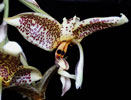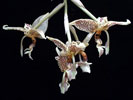|
|
|
|
|
| |
Flasks of
Stanhopea oculata 'CC9439' × self |
|
| |
|
|
| |
| Number: |
TN6765 |
| Name: |
Stanhopea oculata 'CC9439' × self
|
| Type: |
self (What's that?) |
|
Seed Donor: |
Troy C. Meyers
|
|
Click to Enlarge

Pod Parent Flower |
Click to Enlarge

Pod Parent Closeup of Hypochile |
Click to Enlarge

Pod Parent Inflorescence |
|
|
|
| |
Culture Notes from Donor: Parent plant: Temperature range I (60-83°F)
Comments: This TN is not available for export.
Parent plant: This may be my favorite among the Stanhopea oculata plants that I have because of its lithe, multicolored hypochile and chocolate mint fragrance. The plant was identified by the OIC, #9214, as oculata. Medium-sized plant.
For additional origin/habitat information supplied courtesy of
Charles and Margaret Baker, see further below, near the bottom of this page.
|
Temperatures we attempt to use in the lab & greenhouse:
| For Species: |
|
Spring, Summer, Autumn, Winter: days average 77°F, nights 61°F; best fit is Cool-Intermediate 75-58°F
(Source:
Baker's Web OSC) |
| For Species: |
|
Winter: days average 74°F, nights 55°F; best fit is Cool-Intermediate 75-58°F
(Source:
Baker's Web OSC) |
|
About the name...
| Etymology of |
oculata |
|
From Latin "oculatus" with eye-like oval spots.
(Source:
Mayr & Schmucker 1998) |
| Etymology of |
Stanhopea |
|
In honor of Philip Henry, 4th Earl of Stanhope, president of the London Medico-Botanical Society during the early part of the 19th century.
(Source:
Pridgeon 1992) |
| Pronunciation of |
oculata |
|
ok-yoo-LAH-ta
(Source:
Hawkes 1978) |
| Pronunciation of |
Stanhopea |
|
stan-HOPE-ee-ah
(Source:
Pridgeon 1992) |
|
If you would like to direct someone to this web page, please copy and paste this URL into your email:
http://troymeyers.com/d?016765
| Flask Information |
| Availability: |
We have sold all of the flasks for this item. |
| You should: |
Consider getting individual plants or compots instead of a flask.
See if we have plants available in the greenhouse. |
| Yield Estimate: |
150 plants (based on flask surveys done 10/06/2009 through 03/23/2011)
|
| Plantlet Sizes: |
From many flasks 60 - 120 mm plants (based on flask surveys done 03/17/2010 through 07/20/2011)
From one most recently surveyed flask 60 - 100 mm (07/20/2011)
|
|
You might also want to:
|
View the seed assay for this item.
See if we have plants available in the greenhouse.
View items of the same species.
View items of the same genus.
|
| Ordering Information |
| You are not currently logged in. |
|
You must be a registered user and be logged in to reserve a flask or place a notification request. Please log in:
|
|
|
|
|
|
| |
The origin/habitat information below is supplied courtesy of Charles and Margaret Baker
The following information is based on the name of the plant provided by the donor, and assumes that the name is correct. If the plant has been misidentified, then the following information may not be correct.
This text is copyrighted by the Bakers and may not be reproduced without permission.
ORIGIN/HABITAT: Mexico, Belize, Guatemala, Honduras, El Salvador,
Nicaragua, Costa Rica, Panama, northern South America, and Brazil. In
Mexico, the habitat for these plants is on the eastern edge of the Mexican
Plateau and extends from the States of Puebla and Veracruz into the
intermountain regions of Chiapas. In Belize, plants grow in the Cayo and
Toledo Districts at 1300-2450 ft. (400-750 m), where they may be found on
trees, stumps, rotten logs, or rocks in wet broad-leaved forests. In
Guatemala, these plants grow in humid forests as an epiphyte on trees or
on rocky ground at 4900 ft. (1500 m) near Cobán in Alta Verapaz. Plants
are also found in the coastal region along the Pacific slope in Guatemala.
In El Salvador, plants grow in the Department of Santa Ana on Cerro
Montecristo, at 5250-6550 ft. (1600-2000 m). In Nicaragua, this species
grows in Nueva Segovia Province. Plants were collected both on Cerro El
Sangarro and between Ocotal and Jalapa at 3150 ft. (960 m). Plants grow
5-15 ft. (1.5-4.6 m) up the side of trees. In Panama, this orchid is found
in Coclé Province in the region north of El Valle de Antón at 3300 ft.
(1000 m) in wet highland forests where it grows in the tops of the tallest
trees. In Venezuela, plants were found at Caripe at about 3000 ft (910 m)
and between Guácharo Cave and San Francisco in the same habitat as
Stanhopea wardii. In Brazil, these plants are found only at lower
elevations in the State of Amazonas.
Most habitat listings include Mexico, including the states of Chiapas,
Michoacan, Vera Cruz, and Puebla, but McVaugh (1986) indicates that
reports of this species from western Mexico is probably based on the
misidentification of Stanhopea maculosa. He goes on to state that,
"According to Dodson (1963), true S. oculata is found from Puebla and
Veracruz to Central America." However, Kennedy (1975) illustrated a
Stanhopea oculata found at 6000 ft. (1830 m) 10 miles (16 km) southwest
of Taxco in Guerrero, Mexico.
More about this information and the Bakers...
|
|
|
| |
|
|
|